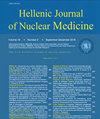18F-FDG在精原细胞瘤检测中的PET/CT值及其与CT和肿瘤标志物水平的相关性——随访长达8年。
IF 0.9
4区 医学
Q4 RADIOLOGY, NUCLEAR MEDICINE & MEDICAL IMAGING
引用次数: 0
摘要
目的氟-18氟脱氧葡萄糖正电子发射断层扫描/计算机断层扫描(18F-FDG PET/CT)不常用于睾丸癌的诊断。与CT不能确定病变性质不同,尤其是在治疗后的情况下,18F-FDG PET/CT通过显示病变内葡萄糖代谢增加来检测活动性疾病。目的探讨18F-FDG PET/CT对精原细胞瘤的检测、治疗效果评价及与CT表现和肿瘤标志物水平的比较。材料与方法选取经精原细胞瘤切除并经组织病理学证实的男性患者72例(年龄39.8±10.1)。18F-FDG PET/CT的适应症为初始分期、化疗/放疗后CT阳性/不确定、CT疑似复发、肿瘤标志物升高。所有患者在首次18F-FDG PET/CT检查后进行了长达8年(中位33.5)的临床随访。利用最大标准化摄取值(SUVmax)目测和半定量分析代谢活性程度。结果氟-18- fdg PET/CT真阳性36例(43.9%),平均SUVmax为7.9±4.8。复发多见于腹膜后淋巴结和肺、骨、肝的远处转移。假阳性6例,假阴性3例。18F-FDG PET/CT的敏感性、特异性、准确性分别为92.3%、86.0%、89.0%,CT的敏感性、特异性、准确性分别为60.8%、66.6%、63.4%。Pearson卡方检验显示,18F-FDG PET/CT与CT结果差异有统计学意义(P=0.016)。18F-FDG阳性PET/CT结果与LDH水平有显著相关性(P=0.043),而AFP、β-hCG之间无显著相关性(P < 0.05)。结论氟-18- fdg PET/CT在评价治疗效果、残余组织活动性病变和正常大小淋巴结、CT阴性和肿瘤标志物升高时均优于CT。乳酸脱氢酶(LDH)升高导致18F-FDG PET/CT阳性。本文章由计算机程序翻译,如有差异,请以英文原文为准。
18F-FDG PET/CT value in the detection of seminoma and correlation with CT and tumor marker levels - up to 8 years of follow-up.
OBJECTIVE
Positron emission tomography/computed tomography using fluorine-18 fluoro-deoxyglucose (18F-FDG PET/CT) is not routinely used for diagnosis of testicular carcinoma. Unlike CT which cannot confirm with certainty the nature of the lesions, especially in post-therapy setting, 18F-FDG PET/CT detects active disease by showing increased glucose metabolism within the lesions.
AIM
Determination of 18F-FDG PET/CT usefulness in detection of seminoma, therapy response evaluation and comparison to CT findings and tumor marker levels.
MATERIAL AND METHODS
Eighty-two men (age 39.8±10.1) after orchiectomy and histopathological confirmation of seminoma were included in this study. Indications for 18F-FDG PET/CT were initial staging, restaging after chemo/radiotherapy with positive/uncertain CT, suspected recurrence on CT, elevated tumor markers. All patients had clinical follow-up of up to 8 years (median 33.5) after the first 18F-FDG PET/CT examination. Degree of metabolic activity was analyzed visually and semi-quantitatively using maximum standardized uptake value(SUVmax).
RESULTS
Fluorine-18-FDG PET/CT was true positive in 36 patients (43.9%) with average SUVmax of 7.9±4.8.Recurrence was mostly found in retroperitoneal lymph nodes and distant metastases in lungs, bones, liver. Six findings were false positive and 3 false negative. Sensitivity, specificity, accuracy of 18F-FDG PET/CT were 92.3%, 86.0%, 89.0% and of CT 60.8%, 66.6%, 63.4%. Pearson Chi-square test showed statistically significant difference between the results of 18F-FDG PET/CT and CT (P=0.016). Significant correlation was found between positive 18F-FDG PET/CT findings and levels of LDH (P=0.043), while non-significant between AFP, β-hCG (P>0.05).
CONCLUSION
Fluorine-18-FDG PET/CT was superior to CT in evaluation of therapy response, active disease in residual tissue and normal size lymph nodes, as well as when CT was negative and tumor markers were elevated. Elevated lactate dehydrogenase (LDH) contributes to positive 18F-FDG PET/CT findings.
求助全文
通过发布文献求助,成功后即可免费获取论文全文。
去求助
来源期刊
CiteScore
1.40
自引率
6.70%
发文量
34
审稿时长
>12 weeks
期刊介绍:
The Hellenic Journal of Nuclear Medicine published by the Hellenic Society of
Nuclear Medicine in Thessaloniki, aims to contribute to research, to education and
cover the scientific and professional interests of physicians, in the field of nuclear
medicine and in medicine in general. The journal may publish papers of nuclear
medicine and also papers that refer to related subjects as dosimetry, computer science,
targeting of gene expression, radioimmunoassay, radiation protection, biology, cell
trafficking, related historical brief reviews and other related subjects. Original papers
are preferred. The journal may after special agreement publish supplements covering
important subjects, dully reviewed and subscripted separately.

 求助内容:
求助内容: 应助结果提醒方式:
应助结果提醒方式:


